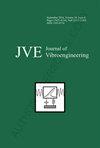Gear error control and response of electric vehicle transmission gearing based on gear trimming
IF 0.9
Q4 ENGINEERING, MECHANICAL
引用次数: 0
Abstract
The lightweight development of electric vehicle motors is a prominent future trend, with the challenge of transmission vibration and noise acting as a key bottleneck that limits the enhancement of power and speed in electric vehicle drive systems. The noise generated by electric vehicle transmissions is primarily associated with the transmission system and gear structure. In line with this, the present study proposes an analysis of transmission error and response mechanisms through gear modifications. The research delves into the analysis of gear deformation and error generation characteristics. It further investigates methods for parametric equation modeling, tooth profile modification, deformation imprint analysis, and vibration response modeling to examine excitation response analysis and noise reduction techniques pertaining to transmission errors. The findings demonstrate that, under 40 % torque, the shaped gear exhibited a maximum reduction in transmission error of 34.2 %, resulting in an overall error improvement of over 5.7 %. Moreover, the maximum error difference after tooth profile and tooth direction shaping exceeded 2 %. The gear-shaping-based electric vehicle transmission showcased favorable economic and technical performance, while its excitation response mechanism provided valuable guidance for mass production. Overall, these results highlight the significance of analyzing transmission errors through gear modifications in achieving lightweight electric vehicle motors. By addressing transmission vibration and noise issues, this research contributes to overcoming limitations and promoting advancements in power and speed within electric vehicle drive systems.基于齿轮微调的电动汽车变速器齿轮误差控制与响应
电动汽车电机的轻量化发展是未来的一个突出趋势,而变速器的振动和噪声问题则是制约电动汽车驱动系统功率和速度提升的一个关键瓶颈。电动汽车变速器产生的噪声主要与变速器系统和齿轮结构有关。有鉴于此,本研究提出了通过修改齿轮来分析变速器误差和响应机制。研究深入分析了齿轮变形和误差产生的特点。研究还进一步探讨了参数方程建模、齿形修改、变形印记分析和振动响应建模等方法,以研究与传动误差有关的激励响应分析和降噪技术。研究结果表明,在 40% 的扭矩下,成形齿轮的传动误差最大减少了 34.2%,总体误差改善了 5.7%。此外,齿廓和齿向整形后的最大误差差异超过 2%。基于插齿的电动汽车变速器展示了良好的经济和技术性能,而其激励响应机制则为批量生产提供了宝贵的指导。总之,这些结果凸显了通过修改齿轮来分析传动误差对于实现电动汽车电机轻量化的重要意义。通过解决变速器的振动和噪音问题,这项研究有助于克服电动汽车驱动系统的局限性,并促进功率和速度方面的进步。
本文章由计算机程序翻译,如有差异,请以英文原文为准。
求助全文
约1分钟内获得全文
求助全文
来源期刊

Journal of Vibroengineering
工程技术-工程:机械
CiteScore
1.70
自引率
0.00%
发文量
97
审稿时长
4.5 months
期刊介绍:
Journal of VIBROENGINEERING (JVE) ISSN 1392-8716 is a prestigious peer reviewed International Journal specializing in theoretical and practical aspects of Vibration Engineering. It is indexed in ESCI and other major databases. Published every 1.5 months (8 times yearly), the journal attracts attention from the International Engineering Community.
 求助内容:
求助内容: 应助结果提醒方式:
应助结果提醒方式:


